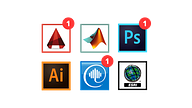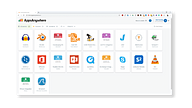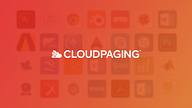7 Benefits of Delivering Apps Using Application Virtualization

Last updated: 30/09/2019
Whether you're considering virtualized application delivery for the first time or looking to use it alongside your existing software deployment technologies, this article will help you understand the benefits and advantages of application virtualization.
In this article, we look at 7 advantages of using application virtualization to deploy your software. For the purposes of the article, we're specifically looking at the benefits of using Numecent's Cloudpaging virtualization technology, a next-generation alternative to Microsoft's App-V or VMware's ThinApp.

Learning topics
- How application virtualization works
- An exhaustive list of benefits and limitations
- Technologies available on the market
- Cost comparisons of app. virtualization solutions
- Cost comparisons against other technologies
The ultimate guide to application virtualization
Read our whitepaper, 'The ultimate guide to Application Virtualization' to learn everything there is to know. Use the panel to the right to download your free e-book.

#1 - Deliver ANY Windows app!
Unlike many legacy technologies (such as imaging and desktop virtualization), application virtualization can be leveraged to deliver all of your Windows apps. Cloudpaging is able to facilitate the delivery of all of your Windows apps. By cleverly using containerization and layering technology, Cloudpaging enables you to deliver 100% of Windows apps on-demand.
When combined with AppsAnywhere, we can help you deliver even the most complex applications to your students, including AutoCAD and MATLAB, backed by AppsAnywhere's thriving community of worldwide educational institutions.

#2 - Reduce the size and number of VDI/Desktop images.
The benefits of VDI are often limited by an inefficient application deployment solution. Just as with physical builds, it's still essential to maintain the integrity of your VDI images. Through the implementation of application virtualization, you can separate the application from the operating system, making your images smaller and rebuilds much less painful.
VDI's decline & more viable solutions:
The Slow Demise of VDI (and The Rise of The University App Store) >>
The imaging market & potentially more effective technologies:
Send Ghost to the grave: problems and alternatives to imaging using Ghost >>
#3 - Update apps any time, with no hassle.
Software manufacturers constantly bring out new patches and updates to keep their software fresh and bug-free. With application virtualization technologies like Cloudpaging, these patches can be pushed directly to the devices and updates will happen instantly in the background. Updates can also be done at any time without interrupting user workflows.


#4 - Leverage BYOD and free hardware from users.
BYOD (bring your own device) is a trend that is here to stay. But you don't need to fear this movement, rather you can leverage all of that free hardware is provided by your users. Application virtualization makes software much more portable, meaning it's far easier to deploy to unmanaged computers. While not every vendor may offer such a license, many do, and this is another money-saving opportunity where you might be able to reduce your computer labs' footprint whilst improving the availability of specialist software.
#5 - Reduced license spend with concurrent licensing.
With advanced application metering facilities as standard, coupled with AppsAnywhere Analytics, IT managers are able to accurately analyze and monitor their license usage to ultimately reduce license spend. This facility has enabled our customers to determine which apps are rarely used, never used or under-used, and apply the vast financial savings to their squeezed annual budgets. This also helps to expose statistics such as launches per delivery method, providing valuable insight and data into how much each technology is leveraged.


#6 - Lose dedicated labs and let apps follow users.
With hundreds of apps and thousands of apps and demanding users, it’s no wonder machines get clogged up and labs have to be dedicated to specific faculties. When apps follow users around campus though, there's no need for IT departments to dedicate labs to course-specific applications. Virtualize your labs with application virtualization and let your apps come to your students!
#7 - Harness the power of local resources.
Virtualized app delivery, such as Cloudpaging, takes advantage of the power of the end device (with falling hardware prices, students often have extremely powerful laptops!). That means apps are run locally without requiring a huge server-based infrastructure (like you would need with VDI). This alternative approach to delivering apps means that the end-user experience isn't compromised. AppsAnywhere’s customers can deliver even their most demanding apps (such as AutoCAD, ArcGIS and NVivo) to any device on campus with only a handful of servers.

Plus two bonus benefits!

#8 - Improve the student experience
Delivering apps that perform with consistent reliability, alongside an experience that remains identical regardless of context (machine, location, OS, app, etc) is key to providing a stellar student experience. It's not only important that apps are delivered; it is important how they are delivered. When used with AppsAnywhere, Numecent's app virtualization solution, Cloudpaging, provides a single access point for users to launch their apps.
#9 - Reduce support tickets & improve support
Thanks again to AppsAnywhere's single point of access for apps and Cloudpaging's ability to consistently deliver any Windows app, software becomes easier to access. Easier access to apps with a consistent method of achieving access each time results in reduced support requirements from end-users. Once end-users are familiar with the process of accessing their applications, support tickets in this context are reduced, allowing IT support to focus upon other matters and close more tickets, faster.

Compare application application virtualization technologies
Download PQR's independent application virtualization smackdown whitepaper to compare Numecent's Cloudpaging [formerly known as Application Jukebox] with other virtualization products on the market, such as App-V and ThinApp. You can find out more about all the application virtualization tools on the market, along with their benefits and advantages, in an industry comparison whitepaper written by leading independent experts.
Application Virtualization Independent Smackdown
(PDF, 2.07 MB)
Download PQR's independent application virtualization smackdown whitepaper to compare Numecent's Cloudpaging [Application Jukebox] technology to other virtualization products on the market.
Try Cloudpaging now
Head over to our demo site and try Cloudpaging's application virtualization technology for free today.
Discover AppsAnywhere...

Improve student outcomes by delivering a better IT service, on and off campus. Make any app available on any device, enable BYOD and repurpose your dedicated lab spaces, all without the need for complex VDI environments.
